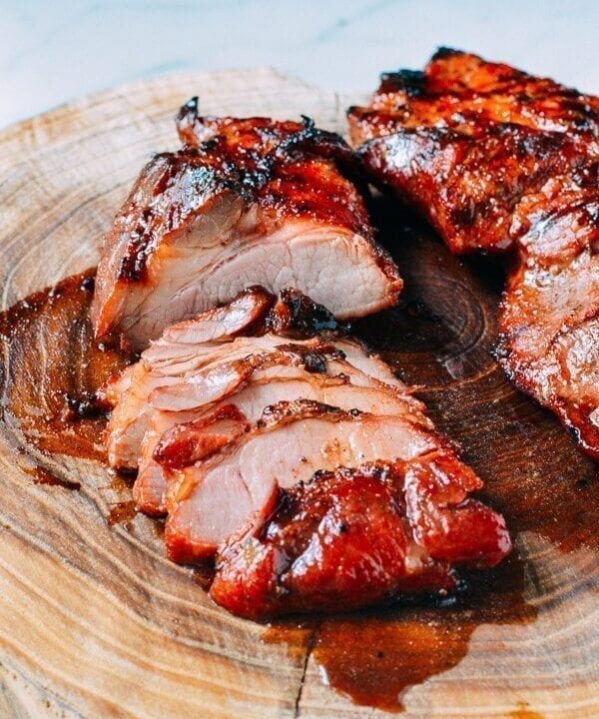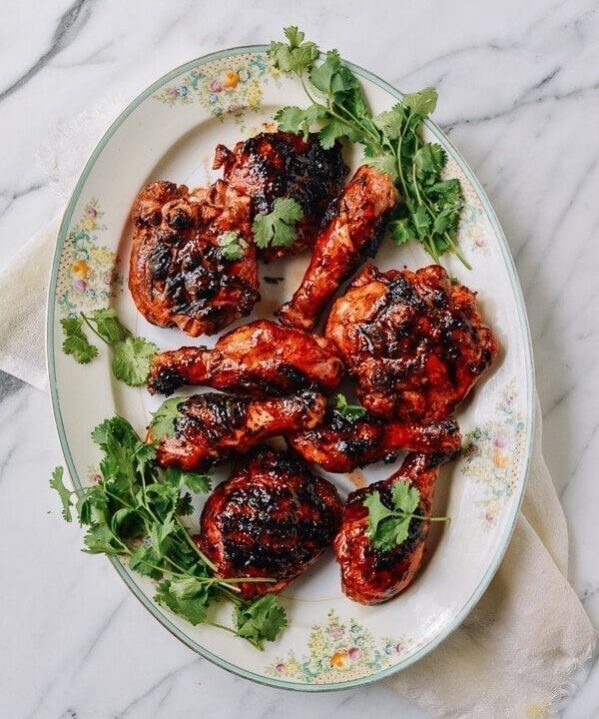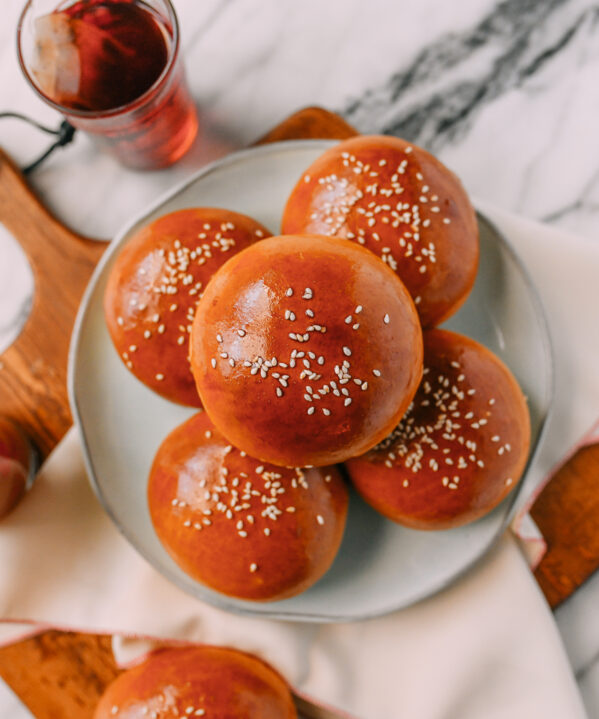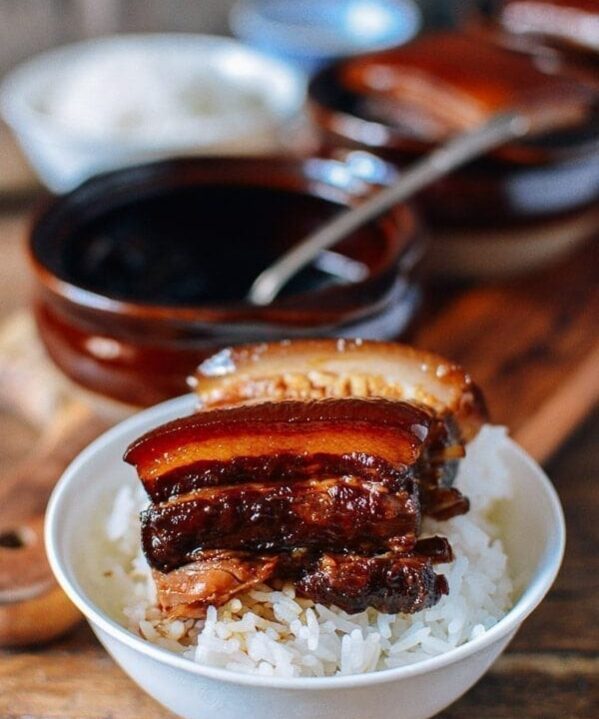Growing up in the Catskills, the first time I saw this Chinese BBQ pork, or char siu, was at the Holiday Inn of all places.
My father, the hotel restaurant’s head chef at the time, used a closely guarded recipe of Chinese sauces, lots of garlic, and spices to make his classic char siu.
While we first posted this recipe on The Woks of Life years ago (February 2014 to be exact), we’ve re-tested and made a few tweaks to the recipe that I’m sure he’d approve of! Also scroll down for a new recipe video!
What Is Char Siu?
Char siu (叉烧) is a type of Cantonese roast meat. Char siu (or slightly different spelling, cha siu) is its Cantonese name, but in Mandarin, it is known as cha shao. To make char siu, pork is marinated in a sweet BBQ sauce and then roasted.
Over the years, the flavor of the char siu one could get in noodle shops and roast meat restaurants in Chinatowns around the world developed a signature sweetness. But today, many restaurants skimp on the spices!
A good char siu recipe has depth of flavor––a salty/sweet contrast with a hint of spice that compliments the pork and allows it to stand alone with just a simple mound of steamed rice and blanched choy sum.
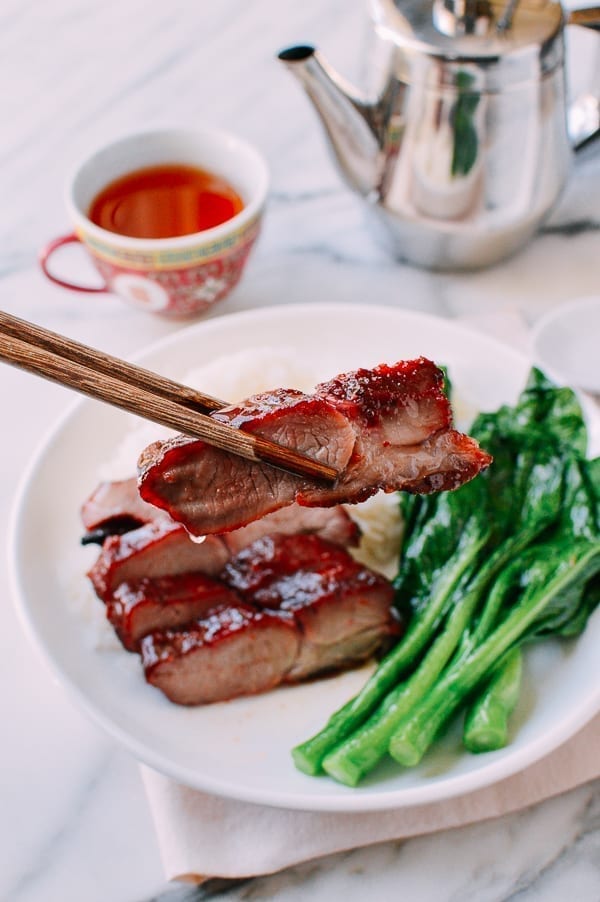
While different cuts of pork can be used to make char siu, from lean boneless pork loin to fattier cuts, those fatty cuts like pork shoulder/pork butt really are best suited to making a tasty Chinese BBQ pork char siu.
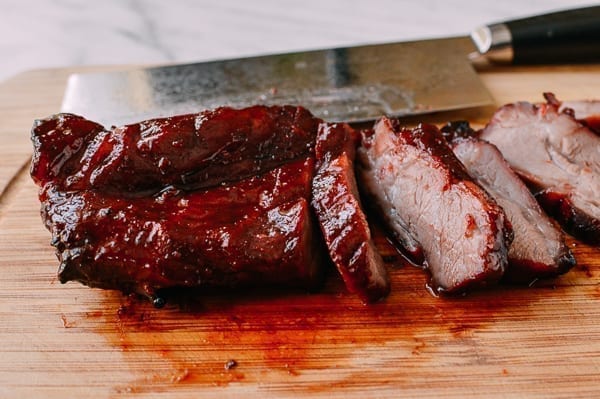
Other Recipes Using Char Siu (Freeze It For Later!)
Once you master how to make char siu at home, you can enjoy it anytime fresh out of the oven without fighting traffic or crowds in Chinatown.
BUT you can ALSO make many more delicious recipes! You can make a big batch, freeze any unused roast pork, and then take it out to make Pork Buns, Pork Fried Rice, and more.
Here are some more recipes you can try:
- Char Siu Bao (Baked BBQ Pork Buns)
- Char Siu Bao (Steamed)
- Classic Pork Fried Rice
- Stir-fried Pork & Mixed Vegetables
- Chinese BBQ Pork Pineapple Buns
- Roast Pork on Garlic Bread
Char Siu Recipe Instructions
Cut the pork into long strips or chunks about 2 to 3 inches thick. Don’t trim any excess fat, as it will render off and add flavor.
Combine the sugar, salt, Chinese five spice powder, white pepper, sesame oil, wine, soy sauce, hoisin sauce, molasses, food coloring (if using), and garlic in a bowl to make the marinade (i.e. the BBQ sauce).
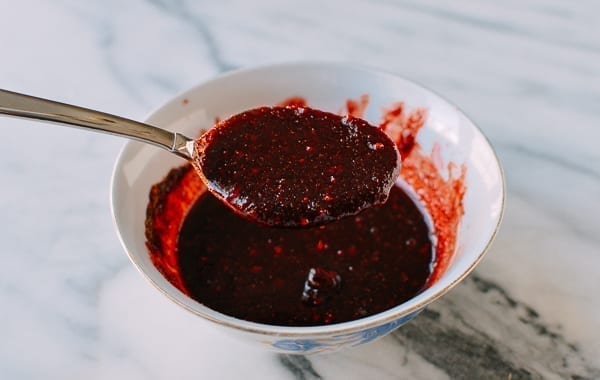
Reserve about 2 tablespoons of marinade and set it aside. Rub the pork with the rest of the marinade in a large bowl or baking dish.
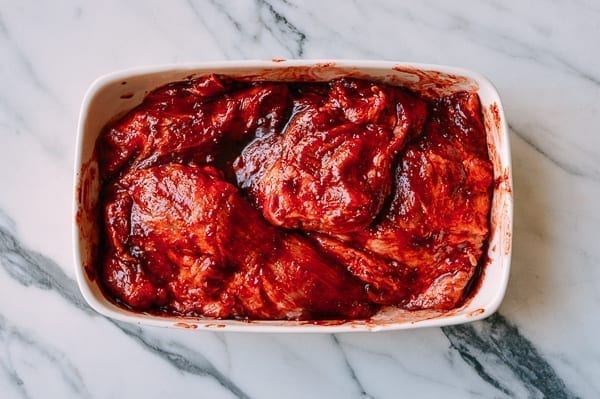
Cover and refrigerate overnight, or at least 8 hours. Cover and store the reserved marinade in the fridge as well.
In my parent’s restaurant, we had a large standing roasting oven the size of a narrow refrigerator, where the pork could hang from these large S-shaped hooks over a pan of water to roast evenly at very high temperatures and get some good color and flavor. To simulate this at home, preheat your oven to ‘bake’ at 475 F (246 C) with a rack positioned in the upper third of the oven. (If you only have a convection oven, keep in mind the oven not only heats more quickly, your char siu will roast faster than what we have described here).
It’s amazing how oven temperatures can vary—from model to model, in different spots in the oven, and in how ovens pre-heat and maintain heat. Using an oven thermometer to double-check the actual oven temperature is a great safeguard to monitor your food (I say double-check because even oven thermostat calibrations vary and can sometimes be incorrect).
Regardless, be sure to check your char siu every 10 minutes, reducing or increasing the temperature as needed.
Line a sheet pan with foil and place a metal rack on top. Using the metal rack keeps the pork off of the pan and allows it to roast more evenly, like it does in commercial ovens described above. Place the pork on the rack, leaving as much space as possible between pieces. Pour 1 ½ cups water into the pan below the rack. This prevents any drippings from burning or smoking.
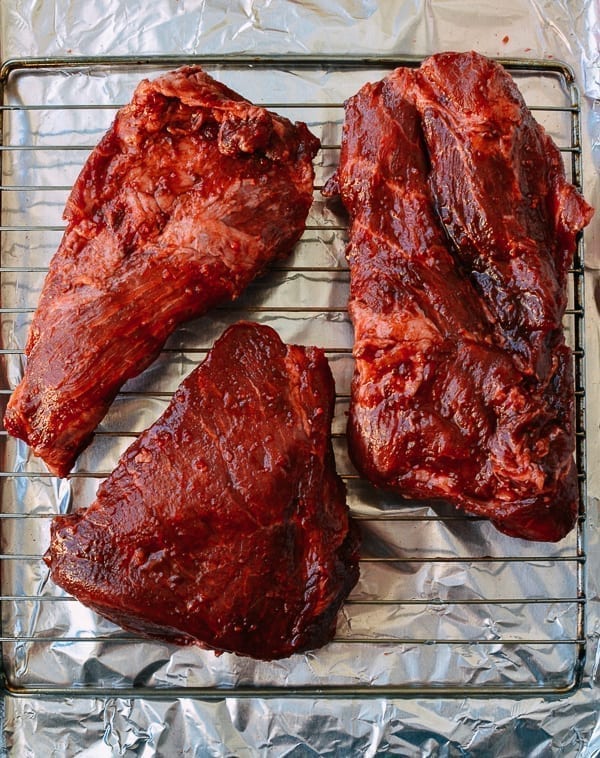
If you don’t own a sheet pan and roasting rack, check out our Chinese Cooking tools page to find our more about the sheet pan and roasting rack we use in our kitchen.
Transfer the pork to your preheated oven. Roast for 25 minutes, keeping the oven setting at 475 F for the first 10 minutes of roasting, and then reduce your oven temperature to 375 F (190 C).
(Update: previously, we called for a roasting temperature of 475F for the full duration of cooking, which, on some home ovens was too hot. We have adjusted the instructions here.)
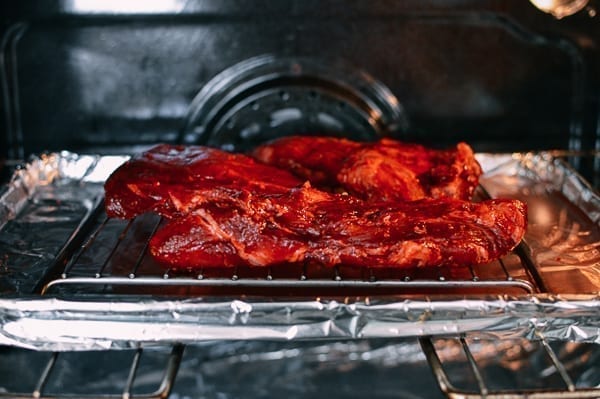
After 25 minutes, flip the pork. If the bottom of the pan is dry, add another cup of water. Turn the pan 180 degrees to ensure even roasting. Roast another 15 minutes. Throughout the roasting time, check your char siu often (every 10 minutes) and reduce the oven temperature if it looks like it is burning!
Meanwhile, combine the reserved marinade with the maltose or honey (maltose is very viscous––you can heat it up in the microwave to make it easier to work with) and 1 tablespoon hot water. This will be the sauce you’ll use for basting the pork.

After 40 minutes of total roasting time, baste the pork…
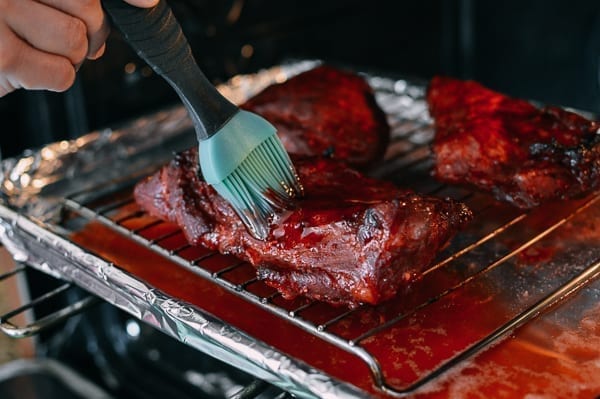
Then flip it, and baste the other side as well. Roast for a final 10 minutes.
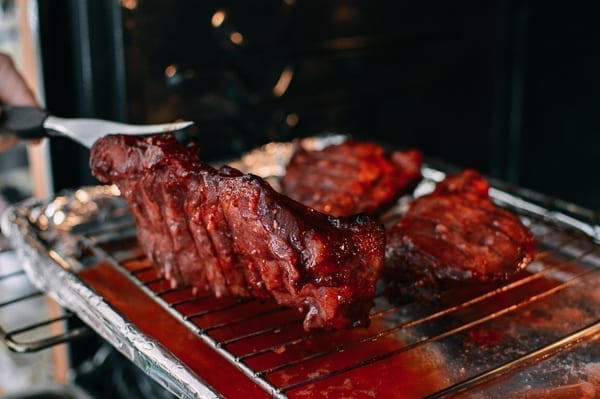
By now, the pork has cooked for 50 minutes total. It should be cooked through and caramelized on top. If it’s not caramelized to your liking, you can turn the broiler on for a couple minutes to crisp the outside and add some color/flavor. Be sure not to walk away during this process, since the sweet char siu BBQ sauce can burn if left unattended. You can also use a meat thermometer to check if the internal temperature of the pork has reached 160 F. (Update: USDA recommends that pork should be cooked to 145 F with a 3-minute resting time)
Remove from the oven and baste with the last bit of reserved BBQ sauce. Let the meat rest for 10 minutes before slicing and enjoy!
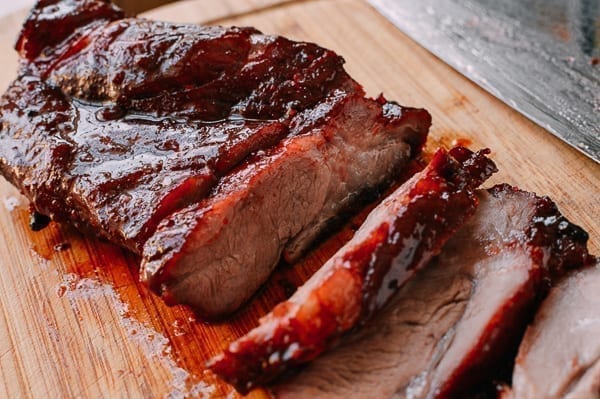
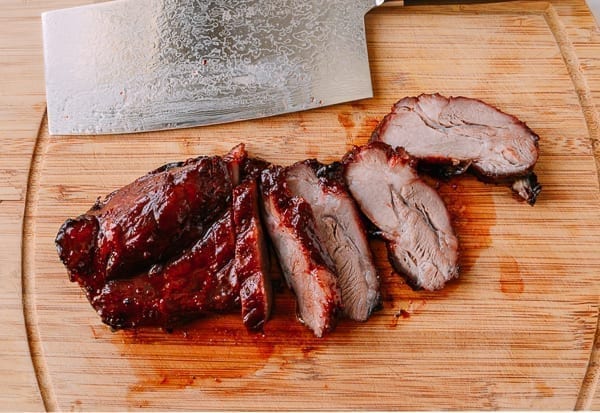
We like to serve our Char Siu with white rice (or brown rice) and greens!
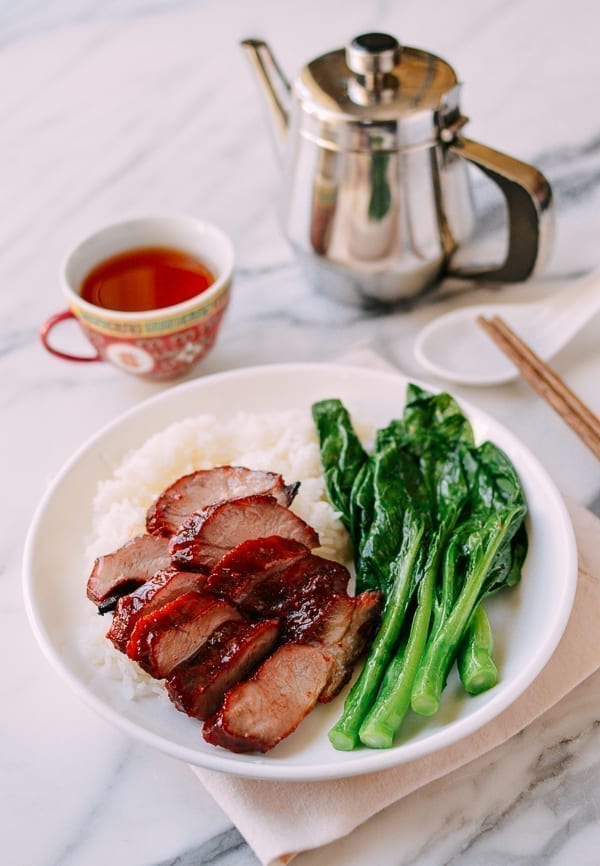
Use Chinese BBQ pork in place of ham in our super easy banquet fried rice recipe, in our Classic Pork Fried Rice, our Chinese BBQ Pork Buns (steamed or baked), or Sarah’s Roast Pork Puffs.
If you want to try this Chinese BBQ pork out on the grill, check out our recipe for BBQ Char Siu on the Grill!
Watch Video!
Char Siu (Chinese BBQ Pork)

Ingredients
- 3 pounds boneless pork shoulder/pork butt (select a piece with some good fat on it)
- ¼ cup granulated white sugar
- 2 teaspoons salt
- ½ teaspoon five spice powder
- ¼ teaspoon white pepper
- ½ teaspoon sesame oil
- 1 tablespoon Shaoxing rice wine
- 1 tablespoon soy sauce
- 1 tablespoon hoisin sauce
- 2 teaspoons molasses
- 1/8 teaspoon red food coloring (optional)
- 3 cloves finely minced garlic
- 2 tablespoons maltose or honey
- 1 tablespoon hot water
Instructions
- Cut the pork into long strips or chunks about 2 to 3 inches thick. Don’t trim any excess fat, as it will render off and add flavor.
- Combine the sugar, salt, five spice powder, white pepper, sesame oil, wine, soy sauce, hoisin sauce, molasses, food coloring (if using), and garlic in a bowl to make the marinade (i.e. the BBQ sauce).
- Reserve about 2 tablespoons of marinade and set it aside. Rub the pork with the rest of the marinade in a large bowl or baking dish. Cover and refrigerate overnight, or at least 8 hours. Cover and store the reserved marinade in the fridge as well.
- Preheat your oven to 'bake' at 475 F (246 C) with a rack positioned in the upper third of the oven. (If you only have a convection oven, keep in mind the oven not only heats more quickly, your char siu will roast faster than what we have described here). It's amazing how oven temperatures can vary—from model to model, in different spots in the oven, and in how ovens pre-heat and maintain heat. Using an oven thermometer to double-check the actual oven temperature is a great safeguard to monitor your food (I say double-check because even oven thermostat calibrations vary and can sometimes be incorrect). Regardless, be sure to check your char siu every 10 minutes, reducing or increasing the temperature as needed.
- Line a sheet pan with foil and place a metal rack on top. Using the metal rack keeps the pork off of the pan and allows it to roast more evenly, like it does in commercial ovens described above. Place the pork on the rack, leaving as much space as possible between pieces. Pour 1 ½ cups water into the pan below the rack. This prevents any drippings from burning or smoking.
- Transfer the pork to your preheated oven. Roast for 25 minutes, keeping the oven setting at 475 F for the first 10 minutes of roasting, and then reduce your oven temperature to 375 F (190 C). After 25 minutes, flip the pork. If the bottom of the pan is dry, add another cup of water. Turn the pan 180 degrees to ensure even roasting. Roast another 15 minutes. Throughout the roasting time, check your char siu often (every 10 minutes) and reduce the oven temperature if it looks like it is burning!
- Meanwhile, combine the reserved marinade with the maltose or honey (maltose is very viscous––you can heat it up in the microwave to make it easier to work with) and 1 tablespoon hot water. This will be the sauce you’ll use for basting the pork.
- After 40 minutes of total roasting time, baste the pork, flip it, and baste the other side as well. Roast for a final 10 minutes.
- By now, the pork has cooked for 50 minutes total. It should be cooked through and caramelized on top. If it’s not caramelized to your liking, you can turn the broiler on for a couple minutes to crisp the outside and add some color/flavor. Be sure not to walk away during this process, since the sweet char siu BBQ sauce can burn if left unattended. You can also use a meat thermometer to check if the internal temperature of the pork has reached 160 degrees F. (Update: USDA recommends that pork should be cooked to 145 degrees F with a 3 minute resting time)
- Remove from the oven and baste with the last bit of reserved BBQ sauce. Let the meat rest for 10 minutes before slicing, and enjoy!

